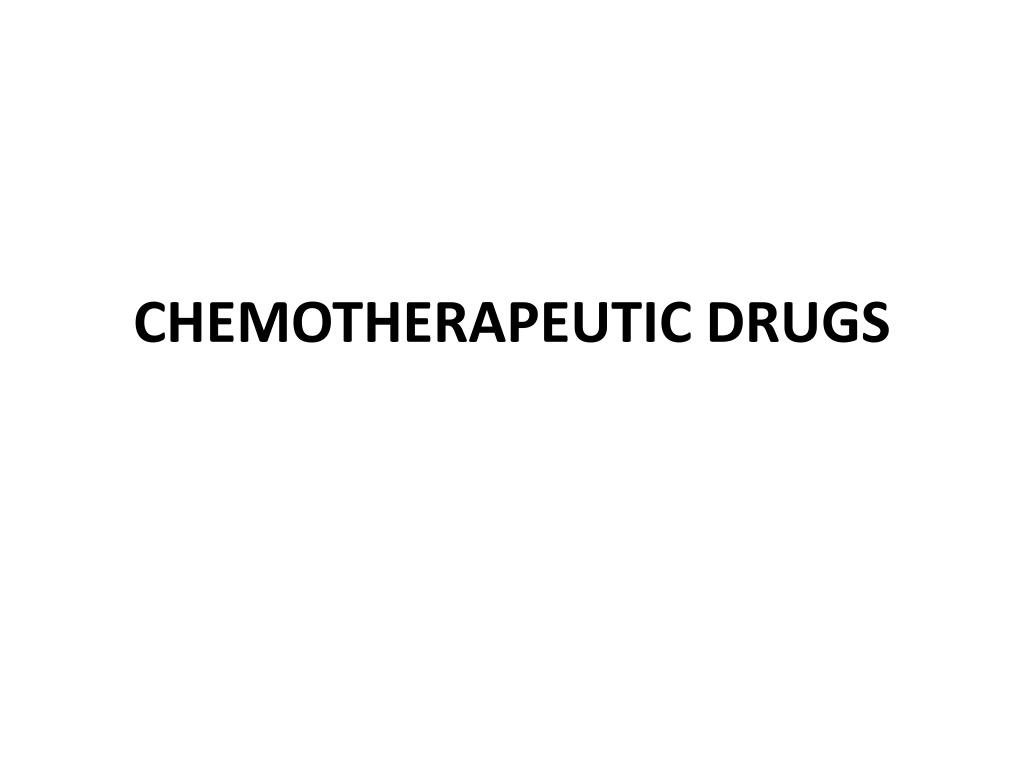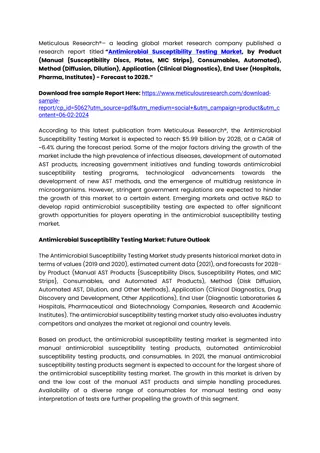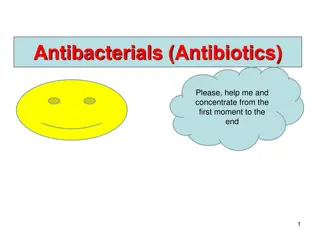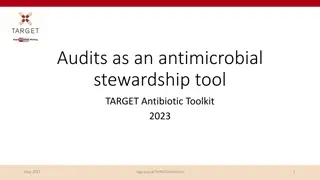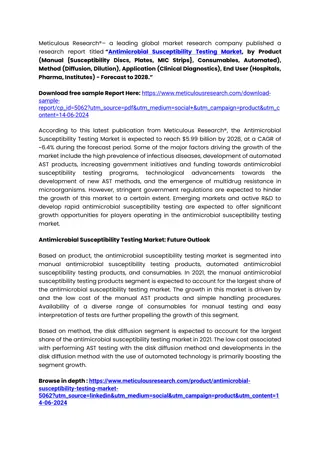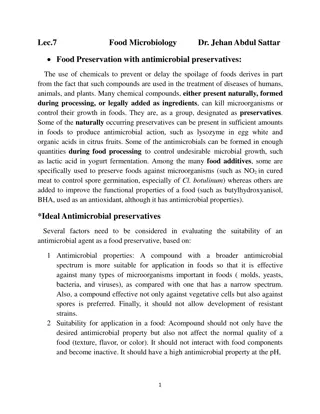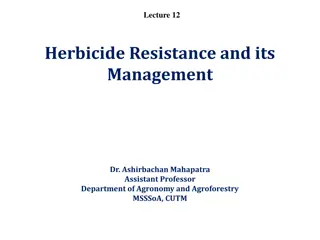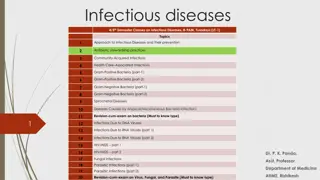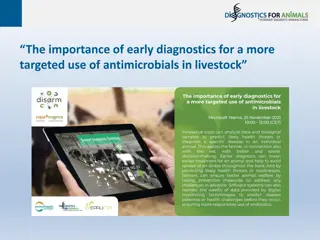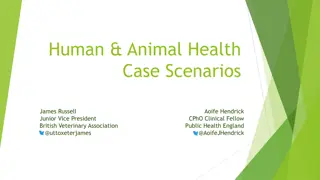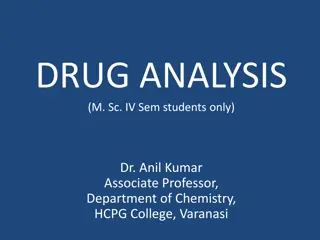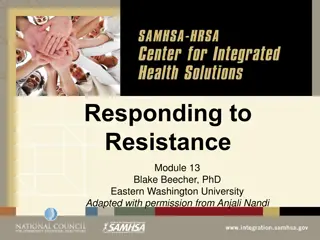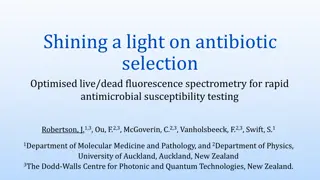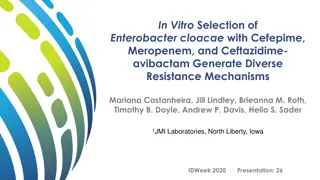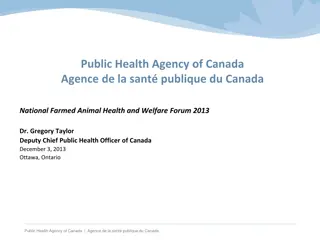Overview of Chemotherapeutic and Antimicrobial Drugs and Resistance Mechanisms
Chemotherapy involves using chemical agents to destroy infective agents and inhibit the growth of cancerous cells, while antimicrobials and antibiotics are used to treat various infections. Anticancer agents, antiprotozoals, and anthelminthics are specific types of drugs used for managing diseases. Mechanisms of antimicrobial drug action include inhibition of cell wall synthesis, cell membrane function, protein synthesis, nucleic acid synthesis, and antimetabolites. Understanding mechanisms of resistance to antibiotics is crucial in combating drug resistance.
Download Presentation

Please find below an Image/Link to download the presentation.
The content on the website is provided AS IS for your information and personal use only. It may not be sold, licensed, or shared on other websites without obtaining consent from the author. Download presentation by click this link. If you encounter any issues during the download, it is possible that the publisher has removed the file from their server.
E N D
Presentation Transcript
Chemotherapy: is the use of chemical agents (either synthetic or natural) to destroy infective agents (microorganisms i.e bacteria, fungus and viruses, protozoa, and helminthes) and to inhibit the growth of malignant or cancerous cells. Chemotherapeutic agents: are chemical which are intended to be toxic for parasitic cell but non toxic to the host.
Antimicrobials: are chemical agents (synthetic/natural) used to treat bacterial, fungal and viral infections. Antibiotics: are substances produced by various species of microorganisms (bacteria, fungi, actinomycetes) that suppress the growth of other microorganisms. Antimicrobial drug exhibits selective toxicity. I.e. the drug is harmful to the parasite without being harmful to the host.
Anticancer agents: Drugs or chemicals used to manage neoplastic diseases. Antiprotozoals: are drugs used to treat malaria, amoebiasis, gardiasis, trichomoniasis, toxoplasmosis, pneumocystis carinii pneumonia, trypanosomiasis and leshmaniasis. Anthelminthics: are drugs used in the treatment of intestinal and tissue worms.
ANTIMICROBIAL DRUGS Mechanisms of antimicrobial drug action: 1. Inhibition of cell wall synthesis 2. Cell membrane function inhibitors 3. Inhibition of protein synthesis 4. Inhibition of nucleic acid synthesis 5. Antimetabolites
Mechanisms of resistance to antibiotics 1. Production of enzymes that inactivate the drug (eg. -lactamase, which inactivates beta lactam antibiotics; acetyl transferases, which inactivate chloramphenicol; kinases and other enzymes, which inactivate aminoglycosides. 2. Alteration of the drug-binding site: this occurs with penicillins, aminoglycosides and erythromycin. 3. Reduction of drug uptake by the bacterium: eg. Tetracyclines 4. Alteration of enzymes: eg. Dihydrofolate reductase becomes insensitive to trimethoprim.
1) Cell wall synthesis inhibitors Members the group: Beta-lactam antibiotics, vancomycin, bacitracine, and cycloserine Beta-lactam antibiotics: Penicillins, cephalosporins, carbapenems, and monobactams. All members of the family have a beta-lactam ring and a carboxyl group resulting in similarities in the pharmacokinetics and mechanism of action of the group members. They are water-soluble, elimination is primary renal and organic anion transport system is used. Penicillins Penicillins have similar structure, pharmacological and toxicological properties. The prototype of penicillins is penicillin G and is naturally derived from a genus of moulds called penicillium.
Core structures of four -lactam antibiotic families. The ring marked B in each structure is the - lactam ring. The penicillins are susceptible to bacterial metabolism and inactivation by amidases and lactamases at the points shown.
Classification: Penicillins can be classified into three groups: 1) Natural Penicillins, 2) Antistaphylococcal penicillins, and 3) Extended-spectrum penicillins.
Mechanism of Action: Penicillins, like all -lactam antibiotics, inhibit bacterial growth by interfering with the transpeptidation reaction of bacterial cell wall synthesis. Sensitive pencillins are inactivatived by beta lactamase enzymes.
Resistance : Resistance to penicillins and other -lactams is due to one of four general mechanisms: (1) inactivation of antibiotic by -lactamase, (2) modification of target Penicillin binding proteins (PBPs), -These resistant organisms produce PBPs that have low affinity for binding - lactam antibiotics, and so are not inhibited except at relatively high drug concentrations.
3) impaired penetration of drug to target PBPs, - Resistance due to impaired penetration of antibiotic to target PBPs occurs only in gram-negative species because of their impermeable outer cell wall membrane, which is absent in gram-positive bacteria (4) efflux- Gram-negative organisms also may produce an efflux pump, which consists of cytoplasmic and periplasmic protein components that efficiently transport some -lactam antibiotics from the periplasm back across the outer membrane.
Pharmacokinetics: Penicillin G is unstable in acid media, hence destroyed by gastric juice. Ampicillin, amoxicillin, and dicloxacillin are acid-stable and relatively well absorbed after oral adminstraion. Oral penicillins should be given 1-2 hours before or after meals to minimize binding to food proteins and acid inactivation (except ampicilin). The absorption of most penicillin is complete and rapid after IM administration. The kidneys rapidly excrete penicillin. Renal excretion is by glomerular filtration (10%) and by tubular secretion (90%). Blood levels of all penicillins can be raised by simultaneous administration of probenecid orally, which impairs tubular secretion of weak acids.
Clinical Uses Natural Penicillins: Penicillin G and penicillin V are natural penicillins. Penicillin G is the drug of choice for infections caused by streptococci (pharyngitis, otitis media), meningococci (Meningitis), enterococci, penicillin-susceptible pneumococci , Gonorrhoea, syphilis, Diphtheria, Tatanus and gas gangrene, non-beta-lactamase-producing staphylococci, Treponema pallidum and many other spirochetes, Bacillus anthracis, Clostridium species, Actinomyces, and other gram positive rods and non-beta- lactamase-producing gram-negative anaerobic organisms.
Penicillin V is acid stable or acid resistant but it is less potent than penicillin G. Similar in antibacterial spectrum to penicillin G. Is active against Nesseria,. They are semisynthetic penicillins 2) Antistaphylococcal Penicillins: [Methicillin, Nafcillin, isoxazolyl penicillins (Oxacillin,cloxacillin, and dicloxacillin)] . They are semi synthetic penicillins These are the penicillinase resistant penicillins. These congeners have side chains that protect the beta lactam ring from attack by staphylococcal penicillinase
The only indication is for infections caused by beta-lactamase (penicillinase)-producing staphylococci. Oral isoxazolyl penicillin is suitable for treatment of mild localized staphylococcal infections, for serious systemic staphylococcal infections, oxacillin or nafcillin, is given by intermittent intravenous infusion.
Extended Spectrum Penicillins: Aminopenicillins (ampicillin, amoxicillin), Carboxypenicillins (Carbenicillin, ticarcillin, effective at lower doses), and Ureidopenicillins (piperacillin, mezlocillin, and azlocillin), Mecillinam (Amdinocillin): Spectrum of activity similar to penicillin G, though having greater activity against bacteria due to their enhanced ability to penetrate the gram-negative outer membrane. The aminopenicillins have the same spectrum and activity, but amoxicillin is better absorbed from the gut and they confer higher blood levels. These drugs are given orally to treat urinary tract infections, respiratory tract infetions such as sinusitis, otitis, and lower respiratory tract infections,meningitis, Gonorrhea, typhoid fever, Bacillary dysentery, Cholecystitis, Subacute bacterial endocarditis, Septicaemia and mixed infections.
Ampicillin IV is useful for treating serious infections caused by penicillin-susceptible organisms, including anaerobes, enterococci, Listeria monocytogenes, and susceptible strains of gram-negative cocci and bacilli such as E coli, H. influenzae, and Salmonella species. Carboxypenicillins extend the ampicillin spectrum of activity to include Pseudomonas aeruginosa and Enterobacter species. The ureidopenicillins resemble ticarcillin except that they are also active against selected gram-negative bacilli, such as Klebsiella pneumoniae. Because of the tendency of P aeruginosa to develop resistance during monotherapy, antipseudomonal penicillins generally is used in combination with an aminoglycoside for pseudomonal infections.
Adverse Reactions: Grouped into three: Allergy (hypersensitivity reaction) Cross sensitivity and cross reactivity among beta-lactams is common. Reactions include: Skin rashes, fever, bronchospasm, Oral lesions, interstitial nephritis (autoimmune reaction to penicillin-protein complex), eosinophilia, hemolytic anemia, vasculitis and anaphylactic shock. Biological: antibiotic assoicated enterocolitis (ampicillin), and Toxic: diarrhea (ampicillin), nephritis, especially methicillin, and platelet dysfunction (antipseudomonal penicillins).
Cephalosporins Cephalosporins are similar to penicillins. More stable to many bacterial -lactamases and therefore have a broader spectrum of activity. Cephalosporins are not active against enterococci and L monocytogenes. Cephalosporins can be classified into four generations depending mainly on the spectrum of antimicrobial activity.
FIRST GENERATION CEPHALOSPORINS First-generation compounds have better activity against gram- positive organisms. Members: Cefadroxil, cefazolin, cephalexin, and cephalothin. These drugs are very active against gram-positive cocci (pneumococci, streptococci, and staphylococci). Escherichia coli, Klebsiella pneumoniae, and Proteus mirabilis are often sensitive, Poor activity against Pseudomonas aeruginosa, indole-positive Proteus, Enterobacter, Serratia marcescens, Citrobacter, and Acinetobacter. Anaerobic cocci (eg, Peptococcus, Peptostreptococcus) are usually sensitive, but B fragilis is not. Cephalexin, and cefadroxil are absorbed from the gut to a variable extent. Urine concentration is usually very high, but in most tissues levels are and generally lower than in serum.
Cefazolin is given IM/IV (the only first generation administered parentrally). Excretion is via the kidney and probenecid may increase serum levels substantially Clinical Uses: Oral drugs may be used for the treatment of urinary tract infections, for minor staphylococcal lesions, or for minor polymicrobial infections such as cellulitis or soft tissue abscess.
Second-generation cephalosporins Members: Cefaclor, cefamandole, and cefuroxime, cefprozil, loracarbef, and ceforanide , . The group is heterogeneous, with marked individual differences in activity, pharmacokinetics, and toxicity. All second-generation cephalosporins are less active against gram-positive bacteria than the first-generation drugs; however, they have an extended gram-negative coverage. Klebsiella and H influenzae are usually sensitive. Can be given orally or parentrally Clinical Uses: Sinusitis, otitis, or lower respiratory tract infections, mixed anaerobic infections, and community- acquired pneumonia.
Third-generation cephalosporins Members: cefotaxime,ceftazidime,ceftriaxone, and proxetil. Antimicrobial activity: The major features of these drugs are the ability of some to cross the blood-brain barrier and their expanded gram-negative coverage (active against Citrobacter, Serratia marcescens, Providencia, and beta-lactamase-producing strains of Haemophilus and Neisseria). Ceftazidime is effective in pseudomonas infections. They can be given orally or IM or IV. They penetrate body fluids and tissues well. Cefotaxime, ceftazidim, and ceftriaxone crosses blood brain barrier, hence inhibit most pathogens, including gram-negative rods. Clinical uses: Gonorrhea (ceftriaxone and cefixime), meningitis (pneumococci, meningococci, H. influenzae, and susceptible enteric gram- negative rods), penicillin-resistant strains of pneumococci (ceftriaxone, cefotaxime), and sepsis
Fourth-generation cephalosporins (e.g.cefepime) It is similar to third-generation agents; However, it is more resistant to hydrolysis by betalactamases. It has good activity against P aeruginosa. Adverse Effects: Cephalosporins are sensitizing and may elicit a variety of hypersensitivity reactions that are identical to those of penicillins. Overgrowth of resistant organisms and fungi may induce superinfection
Beta-lactamase inhibitor Beta-lactamase inhibitors: (clavulanic acid, sulbactam, and tazobactam). They have no antimicrobial activity, and usually combined with beta lactamase labile antibiotics, They irreversibly inhibit beta-lactamases. Examples: Ticarcillin and clavulanate [Timentin], Ampicillin and sulbactam [Unasyn], Amoxicillin and clavulanate [Augmentin].
Monobactams contain a monocyclic beta-lactam ring(e.g. aztreonam). They are relatively resistant to beta-lactamases and active against gram-negative rods. It resembles aminoglycosides in its spectrum of activity. Carbapenems include imipenem and meropenem and have a broad spectrum of activity (against most Gram- positive and negative bacteria). Imipenem is inactivated by a renal proteolytic enzyme and must therefore be combined with cilastatin which inhibits the enzyme.
Vancomycin Vancomycin is active only against gram-positive bacteria, particularly staphylococci. It inhibits cell wall synthesis. Vancomycin is poorly absorbed from the intestinal tract and is administered orally only for the treatment of antibiotic-associated enterocolitis caused by Clostridium difficile. Parenteral doses must be administered intravenously. The drug is widely distributed in the body. Ninety percent of the drug is excreted by glomerular filtration. Clinical Uses: Parenteral vancomycin is indicated for sepsis or endocarditis caused by methicillin-resistant staphylococci. It irritates the tissues surrounding the injection site and is known to cause a red man or red neck syndrome.
Bacitracin Bacitracin is active against gram-positive microorganisms. It inhibits cell wall formation. It is markedly nephrotoxic if administered systemically, thus limited to topical use. Bacitracin is poorly absorbed. Cycloserine Cycloserine inhibits many gram-positive and gram-negative organisms. It is used almost exclusively to treat tuberculosis caused by strains of M tuberculosis resistant to first-line agents. It is widely distributed in tissues. Most of the drug is excreted in active form into the urine. Cycloserine causes serious dose-related central nervous system toxicity with headaches, tremors, acute psychosis, and convulsions.
Cell Membrane Function Inhibitors Antimirobials such as polymyxins acts on gram negative bacteria affecting the functional integrity of the cytoplasmic membrane making macromolecules and ions escape from the cell and cell damage and death occurs. The two most well known agents are polymyxin B and colistin. Polymyxins are effective against Gram-negative bacteria, particularly pseudomonas species. adverse effects nephrotoxicity dizziness, altered sensation and neuromuscular paralysis.
Protein Synthesis Inhibitors Bacteria have two ribosomal subunits; 30S and 50S. The 30S subunit binds mRNA in initiation and holds growing peptide chain. The 50S subunit accepts / translocates charged tRNAs. Protien synthesis inhibitors are divided into two groups: bacteriostatic eg Chloramphenicol, macrolides, clindamycin (Lincosamides), and tetracyclines Bactericidal eg aminoglycosides
Bacterial protein synthesis and sites of drug action
Steps in bacterial protein synthesis and targets of several antibiotics. Amino acids are shown as numbered circles. The 70S ribosomal mRNA complex is shown with its 50S and 30S subunits. In step 1, the charged tRNA unit carrying amino acid 8 binds to the acceptor site A on the 70S ribosome. step 2 The peptidyl tRNA at the donor site, with amino acids 1 through 7, then binds the growing amino acid chain to amino acid 8 (transpeptidation) step 3 The uncharged tRNA left at the donor site is released step 4 the new 8-amino acid chain with its tRNA shifts to the peptidyl site (translocation). The antibiotic binding sites are shown as triangles Chloramphenicol (C) and macrolides (M) bind to the 50S subunit and block transpeptidation (step 2). The tetracyclines (T) bind to the 30S subunit and prevent binding of the incoming charged tRNA unit (step 1).
Chloramphenicol Chloramphenicol is a bacteriostatic broad-spectrum antibiotic that is active against both aerobic and anaerobic gram-positive and gram-negative organisms. It is active also against rickettsiae. Haemophilus influenzae, N. meningitidis, and some strains of Bacteroides are highly susceptible, and for them chloramphenicol may be bactericidal. Clinically significant resistance emerges and may be due to production of chloramphenicol acetyltransferase, an enzyme that inactivates the drug. This is by the transfer of R- factor by conjugation. Also decreased permeability into the resistant bacterial cells and lowered affinity of bacterial ribosome for chloramphenicol is another mechanism.
Mechanisms of action: Chloramphenicol blocks proper binding of 50S site which, stops protein synthesis. It does inhibit mitochondrial ribosomal protein synthesis because these ribosomes are 70S, the same as those in bacteria. It hinders the transfer of the elongating peptide chain to the newly attached amino acyl tRNA at the ribosome mRNA complex. It specifically attaches to the 50S ribosome and therefore hinder the access of aminoacyl-tRNA to the acceptor for amino acid incorporation It prevents formation of peptide bond This may be responsible for the dose related anemia caused by chloramphenicol
Pharmacokinetics: Following oral administration, chloramphenicol is rapidly and completely absorbed. It is widely distributed to virtually all tissues and body fluids. The drug penetrates cell membranes readily. Excretion of active chloramphenicol and of inactive degradation products occurs by way of the urine. A small amount of active drug is excreted into bile or feces. Newborns less than a week old and premature infants clear chloramphenicol inadequately.
Clinical Uses: Because of potential toxicity, bacterial resistance, and the availability of other effective drugs, chloramphenicol may be considered mainly for treatment of serious rickettsial infections, bacterial meningitis caused by a markedly penicillin-resistant strain of pneumococcus or meningococcus, and thyphoid fever.
Adverse Reactions Gastrointestinal disturbances: Adults occasionally develop nausea, vomiting, and diarrhea. Oral or vaginal candidiasis may occur as a result of alteration of normal microbial flora. Bone marrow disturbances: Chloramphenicol commonly causes a dose-related reversible suppression of red cell production at dosages exceeding 50 mg/kg/d after 1-2 weeks. Aplastic anemia is a rare consequence of chloramphenicol administration by any route. It is an idiosyncratic reaction unrelated to dose, though it occurs more frequently with prolonged use. It tends to be irreversible and can be fatal.
Toxicity for newborn infants: Newborn infants lack an effective glucuronic acid conjugation mechanism for the degradation and detoxification of chloramphenicol. Consequently, when infants are given dosages above 50 mg/kg/d, the drug may accumulate, resulting in the gray baby syndrome, with vomiting, flaccidity, hypothermia, gray color, shock, and collapse. Interaction with other drugs: Chloramphenicol inhibits hepatic microsomal enzymes that metabolize several drugs. Like other bacteriostatic inhibitors of microbial protein synthesis, chloramphenicol can antagonize bactericidal drugs such as penicillins or aminoglycosides
Tetracyclines The tetracyclines are a large group of drugs with a common basic structure and activity. All tetracyclines have a nucleus of four cyclic rings. They are called broad spectrum antiboitics. All tetracyclines are slightly bitter solids, weak water soluble, however their hydrochlorides are more soluble.
Tetracyclines are classified as short acting (chlortetracycline, tetracycline, oxytetracycline), intermediate acting (demeclocycline and methacycline), or long-acting (doxycycline and minocycline) based on serum half-lives
MECHANISM OF ACTION They inhibit protein synthesis by binding to 30S ribosomal subunit at a site that blocks binding of charged tRNA to the 30S site of the ribosome. They are bacteriostatic. Tetracyclines can inhibit mammalian protein synthesis, but because they are "pumped" out of most mammalian cells do not usually reach concentrations needed to significantly reduce mammalian protein synthesis.
Antimicrobial activity: Tetracyclines are broad-spectrum antibiotics. They are active against many gram-positive and gram-negative bacteria, including anaerobes, rickettsiae, chlamydiae, mycoplasmas, and are active against some protozoa. The main mechanisms of resistance to tetracycline, is decreased intracellular accumulation due to either impaired influx or increased efflux by an active transport protein pump.
Resistance Three mechanisms of resistance (1) impaired influx or increased efflux by an active transport protein pump, so this efflux protein pumps tetracycline out; (2) plasmid mediated synthesis of a protection protein which protects the ribosomal binding site from binding to tetracycline. (3) enzymatic inactivation of tetracyclines. The most important of these are production of an efflux pump and ribosomal protection. Tet(AE) efflux pump-expressing gram-negative species are resistant to the older tetracyclines, doxycycline, and minocycline. Tet(K) efflux pump of staphylococci confers resistance to tetracyclines, but not to doxycycline, minocycline, or tigecycline, none of which are pump substrates. The Tet(M) ribosomal protection protein expressed by gram-positives produces resistance to the tetracyclines, doxycycline, and minocycline, but not to tigecycline,
Pharmacokinetics: Tetracyclines mainly differ in their absorption after oral administration and their elimination. Doxycycline better absorbed after oral administration than tetracycline. A portion of an orally administered dose of tetracycline remains in the gut lumen, modifies intestinal flora, and is excreted in the feces. Absorption occurs mainly in the upper small intestine and is impaired by food (except doxycycline and minocycline); by divalent cations (Ca2+, Mg2+, Fe2+) or Al3+; by dairy products and antacids, which contain multivalent cations; and by alkaline pH.
They are distributed widely to tissues and body fluids except for cerebrospinal fluid. Minocycline reaches very high concentrations in tears and saliva, which makes it useful for eradication of the meningococcal carrier state. Tetracyclines cross the placenta to reach the fetus and are also excreted in milk. Doxycycline, in contrast to other tetracyclines, is eliminated by non renal mechanisms
Clinical uses: A tetracycline is the drug of choice in infections with Mycoplasma pneumoniae, chlamydiae, rickettsiae, and some spirochetes, cholera, Brucellosis, Plague, relapsing fever due to Borrelia recurrentia, Venereal diseases. They are used in combination regimens to treat gastric and duodenal ulcer disease caused by Helicobacter pylori. They may be employed in various gram-positive and gram- negative bacterial infections, including Vibrio infections. A tetracycline in combination with an aminoglycoside is indicated for plague, tularemia, and brucellosis. Tetracyclines are sometimes employed in the treatment of E. histolytica or P. falciparum.
Tetracyclines are second choice drugs To penicillins for tetanus, anthrax, actinomycosis and Listeria infections To ciprofloxacin for gonorrhoea To ceftriaxone for syphylis To cotrimoxazole for chancroid , E. coli infections. To streptomycin for tularemia
